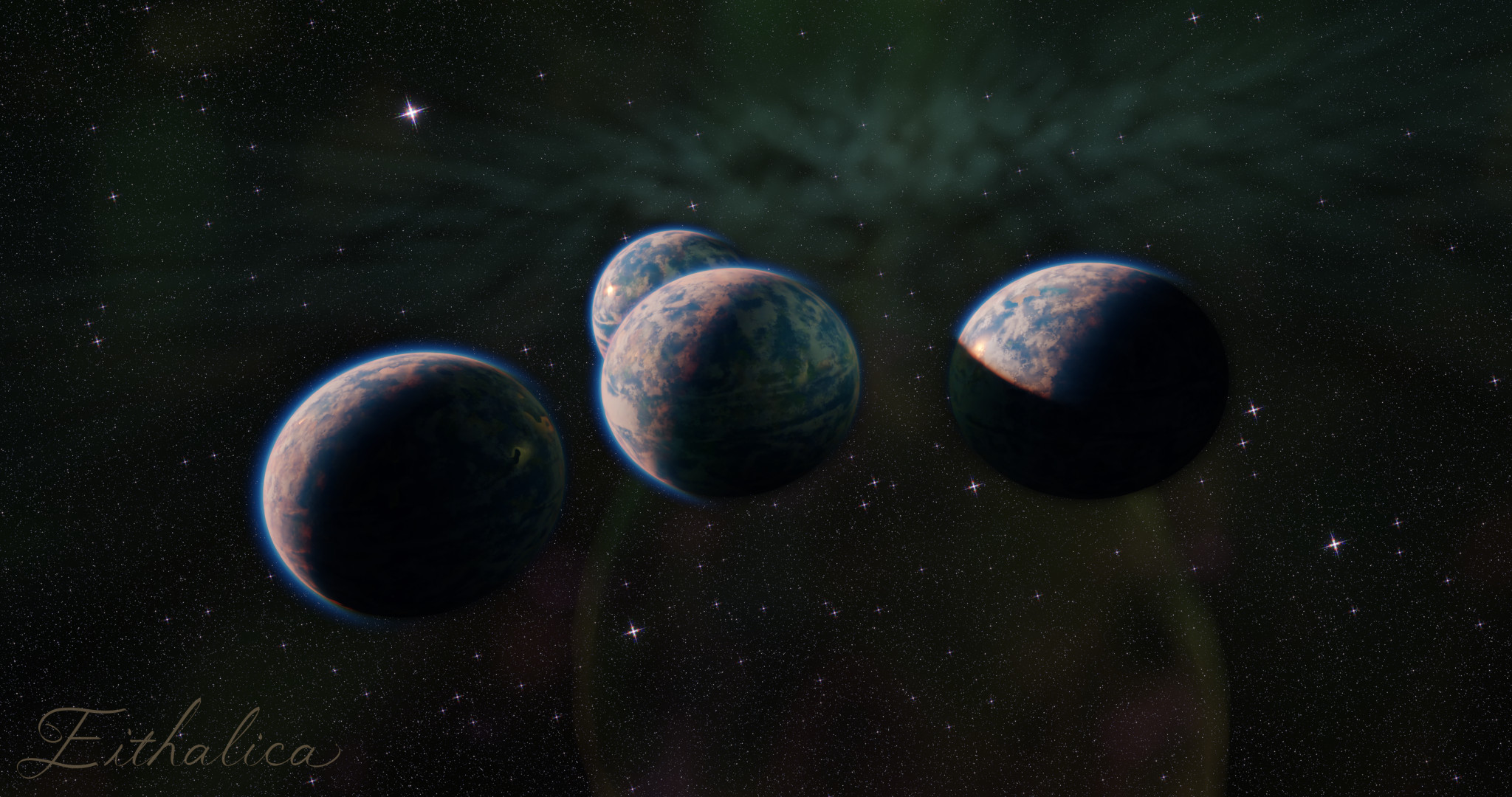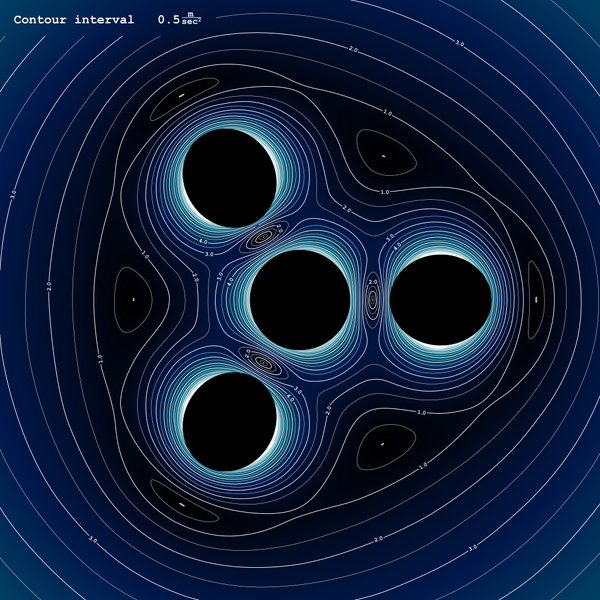Eithalica (planets)
|
Type |
|
|---|---|
|
Number of bodies |
4 |
|
Total mass |
23.05 × 1024 kg |
|
Component radius[1] |
24.97 × 106 m |
|
Direction of rotation |
prograde (same direction as orbit) |
|
Orbital period |
31,754,824 sec (367.53 Earth days) 1,575 mios |
|
Orbital radius |
150.23 × 109 m |
|
Axial tilt |
22.9° |
|
Members |
Eithalica (pronounced “eye-thal-ik-ah” — ipa: /aiθˈælɪkə/) is a planet cluster of four bodies, or a “quadruple planet.” It is the second satellite of the star Ios (the first being Trech), and is home to the Chetnum civilization and two known intelligent species:
- Klevem, a humanoid species, and
- Yalengem, a flying tetrachromat with pronounced bioluminescence.
The celestial bodies of Eithalica include:
- Eith, the one in the center and the largest (by a slim margin).
- Three outer bodies or “moons” (the term “moon” here is used loosely):
Partly due to the Lethean Age, the people of Chetnum have not yet explored much of Eithalica. To this day, they know very little about Siothum, Temalar, and the non-chesward parts of Eith.
Description
All the bodies in Eithalica have nearly the same physical characteristics, which (when considered per-body) are essentially earth-like: mass, mean radius, mean density, surface gravity, general composition, climate, etc. They even have comparable types of global ecosystems and share some flora and fauna. This approximate homogeneity is one of the para-natural traits of the system and gives rise to its classification trouble.
On top of these similarities, the orbital configurations of Eithalica are striking in at least four ways:
- All three “moons” orbit extremely close to Eith (and each other) with very short periods.
- All orbits are geostationary to Eith, a condition kept stable by tidal forces.
- All bodies are tidally locked to each other.
- The system is radially symmetrical, another para-natural trait.
Due to these characteristics, all the moons have Roche limits that are even closer to Eith’s surface than the moons are themselves. This means that, although they are so prolate that it's obvious to the naked eye, each moon is still internally stable. In fact, the lack of variability in prolateness means no added stress from tidal flexing (and therefore no extra volcanism).
As a result of the system-wide tidal locking and geostationary orbits, Eithalica behaves almost like one contiguous, rigid mass—as though its members are all fixed to each other by invisible arms. This, together with the extreme closeness of the moons, made it possible for Chetnum to build a bridge from Eith to Chessol during the Imperial Age.
The gravitational pattern results in nine different Lagrange points that are also fixed relative to the system.
Moon Bridge
Main article: Moon Bridge
Lorem ipsum dolor sit amet …
Effective Potential Map
This map approximately shows the effective potential within the Eithalica system, which is similar to free-fall acceleration with centrifugal force taken into account. It reveals nine Lagrange points in the system (not counting any produced with the host star or neighboring planets).
Celestial Classification
Eithalica is a unique system that resists conventional classification.
A casual observer might see that Eith (the central planet) sits permanently in the center of all the “lunar” orbits, and suppose this means Eith is the host for those orbits. But this is a deceptive consequence of the system’s overall symmetry. In reality, the gravity from Eith plays a smaller role in defining each moon’s orbit than does the combined gravity from the other two moons. So the system is truly mutual like a quadruple star, but of planets. Hence it receives the term “quadruple planet.”
In this wiki and other real-life English works, the outer bodies of Eithalica are still called “moons” in a virtual sense, and for simplicity. However, a moon is defined as a naturally occurring satellite, i.e. a body which orbits another. To say that one body orbits the other, and not vice versa, is to presume a hierarchy between the two which in the case of Eith and each of its moons is very tenuous.
Theoretically all bodies in a system exert at least some gravitational force on all other bodies in the system, but for most planets the masses involved are defined by a hierarchy so enormous that it’s unmistakable and indisputable. Often the influence of the smaller bodies on the larger is negligible.
When there is dispute, usually in real life (so far) it’s over possible dwarf planets. Every one of Eithalica’s bodies is too large to be remotely considered “dwarf-size,” yet it still exists at an utmost edge of these definitions—a new, somewhat different edge.
Para-Natural Traits
“Para-natural” is a novel term used in this wiki to describe certain traits of Eithalica that, while currently adhering to known physics, defy typical expectations for natural celestial objects, due to questions of origin and formation process.
Eithalica’s para-natural traits are:
- its homogeneity (mutual similarity among all members),
- its radial symmetry, and
- general similarities in (or exact recurrences of) flora and fauna, among bodies in Eithalica as well as real-life Earth.
These traits only become problematic in certain cosmogonies (especially Big Bang theory), and not in astronomy or cosmology itself. Unfortunately, this wiki can offer no in-story way to discuss cosmogony.
Popular ideas like artificial planets, directed panspermia, or convergent evolution may provide an aid in suspension of disbelief for some, but be advised that these will never be acknowledged in the story canon of Eithalica.


